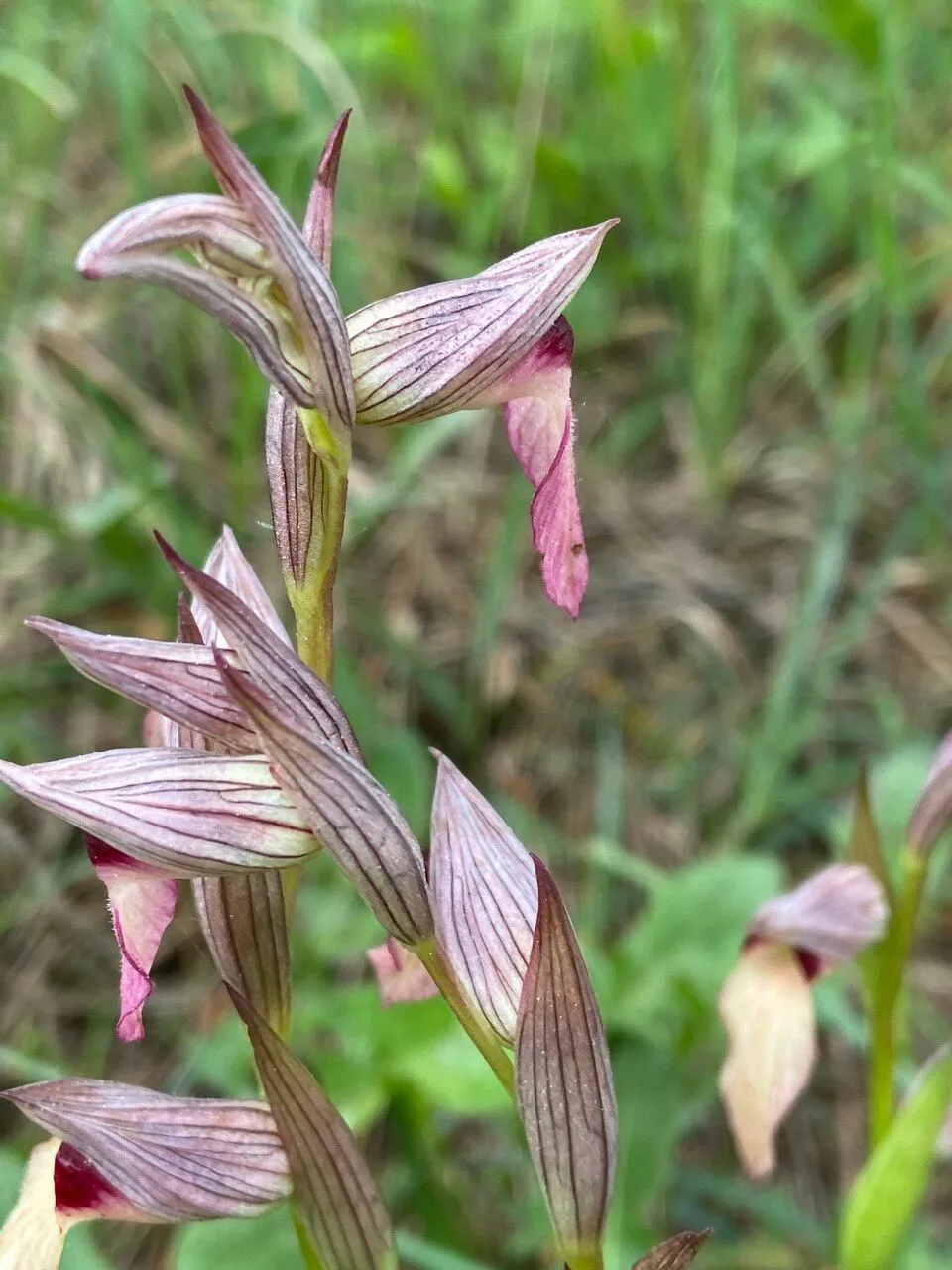
Author: L.
Bibliography: Sp. Pl.: 950 (1753)
Year: 1753
Status: accepted
Rank: species
Genus: Serapias
Vegetable: False
Observations: Medit.
The Tongue-orchid, scientifically known as Serapias lingua, is a captivating species belonging to the family Orchidaceae. First documented in 1753 by the botanist Carl Linnaeus, this exquisite plant has since captivated botanists and naturalists alike with its unique characteristics and elegant appearance.
Native to the Mediterranean region, the Tongue-orchid thrives in its natural habitat, which includes grasslands, open woodland areas, and scrublands. Its adaptability to various environmental conditions within this locale underscores its resilience and ecological importance.
One of the defining features of the Tongue-orchid is its striking floral structure. The plant derives its common name from its distinctive lip, which bears a resemblance to a tongue. The flowers of Serapias lingua are typically composed of a helmet-shaped structure formed by the fusion of the sepals and petals. The lip is usually adorned with vibrant hues ranging from reddish-brown to maroon, accentuated by intricate patterns that serve to attract its pollinators.
The Tongue-orchid’s flowering season extends from late spring to early summer, during which it displays its captivating blooms. The intricate design of its flowers plays a crucial role in its pollination strategy. The plant depends primarily on insects for pollination, and its unique floral architecture entices these visitors by providing a safe haven and easy access to its nectar.
This orchid’s ecological role extends beyond its allure. By participating in intricate pollination interactions, it plays a part in maintaining the biodiversity and stability of its Mediterranean ecosystem. Moreover, understanding the lifecycle and reproductive strategies of Serapias lingua offers valuable insights into the conservation needs of orchid species globally, many of which face threats from habitat loss and environmental changes.
Though not as widely known as some other orchid species, the Tongue-orchid stands out for its ecological significance and captivating beauty. Preservation efforts are essential to ensure that this remarkable plant continues to flourish in its native environment, contributing to the rich tapestry of plant life characteristic of the Mediterranean basin.
Deu: zungen-stendelwurz
Eng: tongue-orchid
En: Tongue-orchid, Tongue Orchid, Tongue Serapias
Ca: Gall llengut
Nl: Gewone tongorchis
Fr: Sérapias petite langue, Sérapias à languette, Sérapias-langue, Elléborine à languette, Helléborine à languette, Sérapias langue
De: Einschwieliger Zungenstendel, Zungen-Stendelwurz, Zungenstendel, Zungensumpfwurz
It: Serapide lingua, Satirio incappuciato
Mt: Bajdet il-fenek, Orkida tal-ilsien
Es: Serapias en lengua
Taken May 3, 2020 by Llandrich anna (cc-by-sa)
Taken May 3, 2020 by Llandrich anna (cc-by-sa)
Taken May 2, 2020 by Llandrich anna (cc-by-sa)
Taken May 12, 2020 by Llandrich anna (cc-by-sa)
Taken Apr 29, 2016 by Susana López (cc-by-sa)
Taken Apr 26, 2022 by Tristan Jaton-Maria (cc-by-sa)
Taken May 7, 2019 by Sergio costantini (cc-by-sa)
Taken Apr 26, 2022 by Tristan Jaton-Maria (cc-by-sa)
Taken May 12, 2020 by Llandrich anna (cc-by-sa)
Taken May 2, 2020 by Llandrich anna (cc-by-sa)
Taken Jun 7, 2019 by Gisèle Caron (cc-by-sa)
Taken May 25, 2019 by Llandrich anna (cc-by-sa)
Taken May 3, 2020 by Llandrich anna (cc-by-sa)
Taken May 2, 2020 by Llandrich anna (cc-by-sa)
Taken May 12, 2020 by Llandrich anna (cc-by-sa)
Taken Jan 15, 1995 by Photoflora – Benoit BOCK (©)
Taken May 7, 2022 by Miguel Ángel Segovia (cc-by-sa)
Taken May 23, 2021 by Renaud Brochiero (cc-by-sa)
Taken May 10, 2021 by Sergio costantini (cc-by-sa)
Taken May 2, 2019 by huy HO (cc-by-sa)
Taken Apr 27, 2019 by sendermen sendermen (cc-by-sa)
Taken Apr 29, 2020 by Alain rivière (cc-by-sa)
Taken Apr 15, 2017 by Tela Botanica − Liliane ROUBAUDI (cc-by-sa)
Taken May 12, 2016 by Tela Botanica − Alain BIGOU (cc-by-sa)
Taken Apr 22, 2022 by AbejaRuca Abeja (cc-by-sa)
Taken Apr 15, 2001 by Photoflora – Benoit BOCK (©)
Taken Sep 21, 2021 by sil.7 (cc-by-sa)
Taken Sep 21, 2021 by sil.7 (cc-by-sa)
Taken Sep 21, 2021 by sil.7 (cc-by-sa)
Taken Sep 21, 2021 by sil.7 (cc-by-sa)
© copyright of the Board of Trustees of the Royal Botanic Gardens, Kew.
© copyright of the Board of Trustees of the Royal Botanic Gardens, Kew.
© copyright of the Board of Trustees of the Royal Botanic Gardens, Kew.
Ph maximum: 5.0
Ph minimum: 4.5
Light: 8
Atmospheric humidity: 5
Soil nutriments: 2
Family: Myrtaceae Author: (F.Muell.) K.D.Hill & L.A.S.Johnson Bibliography: Telopea 6: 402 (1995) Year: 1995 Status:…
Family: Rubiaceae Author: Pierre ex A.Froehner Bibliography: Notizbl. Bot. Gart. Berlin-Dahlem 1: 237 (1897) Year:…
Family: Sapindaceae Author: Koidz. Bibliography: J. Coll. Sci. Imp. Univ. Tokyo 32(1): 38 (1911) Year:…
Family: Asteraceae Author: A.Gray Bibliography: Pacif. Railr. Rep.: 107 (1857) Year: 1857 Status: accepted Rank:…
Family: Fabaceae Author: Medik. Bibliography: Vorles. Churpfälz. Phys.-Ökon. Ges. 2: 398 (1787) Year: 1787 Status:…
Family: Aspleniaceae Author: (Cav.) Alston Bibliography: Bull. Misc. Inform. Kew 1932: 309 (1932) Year: 1932…